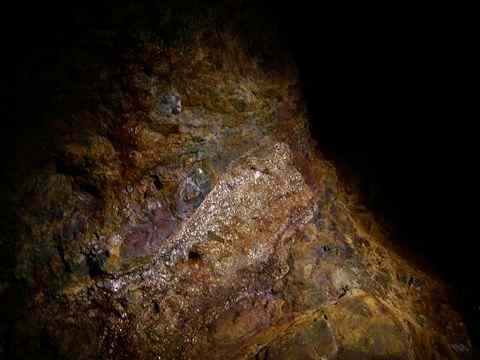Osarizawa Mine
Osarizawa, Kazuno city, Akita pref., Japan
Occurrence
Moderate-T hydrothermal deposit
Moderate temperature hydrothermal deposit associated with the late Miocene (10 Ma) andesitic laccoliths intruded in siliceous mudstone and dacitic pyroclastics of the Shigenai Formation of the same age. The Shigenai Formation is upper sediments of the Miocene Hokuroku Caldera, and the deposit was formed by the volcanic activity of the caldera. The Hokuroku Caldera is 20 km in diameter, and is a caldera complex composed of Miocene submarine volcanos and Miocene-Pliocene terrestrial volcanos. There are at least 13 small calderas and craters in the Hokuroku Caldera. The Shigenai Formation corresponds to the Otaki Formation in the Odate region. The Shigenai Formation is associated with Kuroko Massive Sulfide deposits such as Komaki mine and Omaki mine. Age of volcanic rocks was determined by K-Ar radiometric dating.

Outcrop of a sulfide lode in siliceous mudstone of the Shigenai Formation. The pale yellow band at the center is the lode of sulfides such as pyrite. The lode in approximately 50 cm in width. The dark gray host at the both sides of the lode is siliceous mudstone. The reddish-brown parts near the lode are limonite crusts formed by oxidation of the lode. These lodes were mined by shrinkage method along the platy lodes.
Reported Minerals
- Pyrite
- Chalcopyrite
- Sphalerite
- Copper
- Barite
- Pyromorphite
- Anglesite
- Osarizawaite
- Calcite
- Rhodochrosite
Mineral Assemblages
- Quartz(Gangue) - Chamosite - Chalcopyrite - Pyrite
- Galena - Anglesite - Osarizawaite
Details of the mine
One of the most important Copper mine in Japan in 1940's. There were 4,500 employees in this mine at the best days. This mine mainly produces Gold, Silver, and Copper.
Produced metal (during World War II)
- Copper: 100,000 tons/month
History
- 1596: The Au deposit was discovered.
- 1663: The Cu deposit was discovered.
- 1690's: The Cu deposit was mined.
- 1744 - 1765: Private citizens from Morioka city mined Cu.
- 1765 - 1868: The Cu deposit was by Nambu local government.
- 1889: Iwasaki family, the owner of Mitsubishi group, bought the mine.
- 1892: Western style smelter was built.
- 1918: Mitsubishi Mining Corporation was established.
- 1978: The mine was closed.
Localities
- Kisan-mori Mine (Cu-Pb-Zn)
- Mikawa Mine (Cu-Pb-Zn, Siderite)
- Takami Mine (Cu-Pb-Zn)
- Gunma Mine (Cu-Pb-Zn)
- Yunosawa Mine (Pb-Zn)
- Okuto Mine (Pb-Zn)
- Arakawa Mine (Cu-Zn)
- Osarizawa Mine (Cu-Zn)
- Sayama Mine (Cu-Zn)
- Washinosu Mine (Cu-Zn)
- Yashu Mine (Cu)
- Takaneyama Mine (Cu-Zn-Mn)
- Kawazu Mine (Zn-Au-Te-Mn)
- Manju Mine (Zn)
- Mount Nesugata (Mn oxide)
- Ryushima Mine (Mn carbonate)